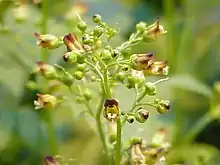Scrophularia
The genus Scrophularia of the family Scrophulariaceae comprises about 200 species of herbaceous flowering plants commonly known as figworts. Species of Scrophularia all share square stems, opposite leaves and open two-lipped flowers forming clusters at the end of their stems. The genus is found throughout the Northern Hemisphere.
| Scrophularia | |
|---|---|
 | |
| Scrophularia nodosa | |
| Scientific classification | |
| Kingdom: | Plantae |
| Clade: | Tracheophytes |
| Clade: | Angiosperms |
| Clade: | Eudicots |
| Clade: | Asterids |
| Order: | Lamiales |
| Family: | Scrophulariaceae |
| Tribe: | Scrophularieae |
| Genus: | Scrophularia L. |
| Species | |
|
About 200, see text | |
Scrophularia species are used as food plants by the larvae of some Lepidoptera species including Phymatopus hectoides.
Some species in this genus are known to contain potentially useful substances, such as iridoids, and several Scrophularia species, such as the Ningpo figwort (S. ningpoensis), have been used by herbal medicine practitioners around the world. The name Scrophularia comes from scrofula, a form of tuberculosis, because several species have been used in herbal medicine for this disease.[1][2]
Selected species


|
|
Notable appearances in media
Figwort features in the final episode of the second season of The Brittas Empire, where Figwort is said to induce Labour, the Leisure Centre parking lot has been taken over by a pregnant cow who decides to snack on some labour inducing figwort. Births start happening all over the place but the medical assistance is a little confused.
References
| Wikimedia Commons has media related to Scrophularia. |
- Culpeper, Nicholas. Culpeper's complete herbal: a book of natural remedies for ancient ills. Wordsworth Editions, 1995.
- Garran, Thomas Avery. Western Herbs According to Traditional Chinese Medicine: A Practitioner's Guide. Inner Traditions/Bear & Co, 2008.